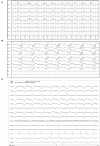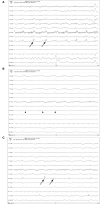Periodic discharges in veterinary electroencephalography-A visual review
- PMID: 36777678
- PMCID: PMC9909489
- DOI: 10.3389/fvets.2023.1037404
Periodic discharges in veterinary electroencephalography-A visual review
Abstract
First described in human EEG over 60 years ago, there are very few examples of periodic discharges in the veterinary literature. They are associated with a wide variety of etiologies, both intracranial and systemic, making interpretation challenging. Whether these patterns are indicative of ictal, interictal, or postictal activity is a matter of debate and may vary depending on the clinical features in an individual patient. Periodic discharges have a repeated waveform occurring at nearly regular intervals, with varying morphology of individual discharges from simple sharp waves or slow waves to more complex events. Amplitudes, frequencies, and morphologies of the discharges can fluctuate, occasionally evolving, or resolving over time. This study presents a visual review of several veterinary cases with periodic discharges on EEG similar to those described in human EEG, and discusses the current known pathophysiology of these discharges.
Keywords: EEG; canine; encephalopathy; epilepsy; feline; seizures; status epilepticus.
Copyright © 2023 Knipe, Bush, Thomas and Williams.
Conflict of interest statement
The authors declare that the research was conducted in the absence of any commercial or financial relationships that could be construed as a potential conflict of interest.
Figures










References
-
- Chatrian GE. An EEG pattern: pseudo-rhythmic recurrent sharp waves. Its relationships to local cerebral anoxia and hypoxia. Electroenceph Clin Neurophysiol. (1961) 13:144.

